Early sweet variety of honeysuckle "Silginka"
Honeysuckle is an early berry that is not afraid of frost. For residents of cold regions, where the variety of crops grown is limited, this berry is a godsend. Rich in vitamins, Silginka will delight you with a harvest of delicious fruits at the beginning of summer.
Description of the honeysuckle variety Silginka
Silginka is a tall shrub of the Honeysuckle family, which is distinguished by its frost resistance and can withstand frosts down to -40°C. The height of the bush reaches 1.5 m. The erect branches form a rounded shape and are slightly dense. One bush develops up to 15-18 green branches, which darken with age. The leaves are medium in size, have an elongated oval shape, in the axils of which flower buds are formed.
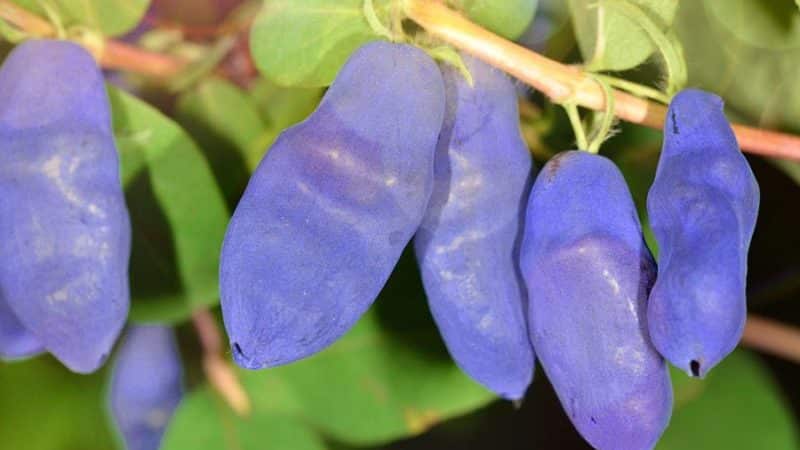
Origin and development
The first cultivated varieties of honeysuckle appeared relatively recently; the plant was especially loved by residents of the northern regions, where the variety of berries that can withstand frost is not so great. Most of the honeysuckle varieties were bred in Russian nurseries.
Silginka is one of the first cultivated varieties of honeysuckle, bred in 1978 in the Tomsk region.
Breeding history
The Silginka variety was obtained by crossing the Turchaninova and Roxana varieties in 2004, and was included in the state register in 2011. The breeders of the Bakchar Research Nursery sought to obtain a variety that would tolerate winter frosts well and produce fruits with high taste.
Chemical composition, trace elements and vitamins, beneficial properties
Honeysuckle berries are much superior to other berry crops in their biochemical composition. It is in the early summer that this important source of vitamins is especially valued.
Honeysuckle contains 9% sugars and 4% acids, a high content of ascorbic acid and active substances important for humans: rutin, leucoanthocyanins, chlorogenic and caffeic acids. These substances increase the strength of capillaries. Honeysuckle fruits are useful for hypertension and atherosclerosis. Their pulp contains a lot of phosphorus, calcium, potassium, magnesium, iron, iodine, manganese, copper, silicon, retinol, B vitamins, etc.
100 g of berries contains:
- ascorbic acid – 150 mg;
- potassium – 70 mg;
- sodium – 35 mg;
- phosphorus – 35 mg;
- magnesium – 22 mg;
- calcium – 20 mg;
- thiamine – 3 mg;
- riboflavin – 3 mg;
- iron – 1 mg;
- beta-carotene – 0.3 mg;
- manganese – 0.1 mg;
- iodine – 0.1 mg;
- copper – 0.1 mg;
- silicon – 0.09 mg;
- aluminum – 0.08 mg;
- strontium – 0.08 mg;
- retinol – 0.05 mg.
The chemical composition and taste of honeysuckle may vary depending on weather and climatic conditions growing. At high humidity, a lot of ascorbic acid accumulates in the berries; in arid regions the content of tannins and sugars is higher.
Eating berries helps:
- removal of heavy metal salts and excess cholesterol from the body;
- stabilize blood pressure;
- normalize the functioning of the digestive tract;
- strengthen the heart muscle;
- improve blood circulation and strengthen the walls of blood vessels;
- strengthen the immune system and help the body fight infections.
Not only honeysuckle berries can bring benefits.Its flowers, leaves and bark contain many useful substances that have anti-inflammatory, diuretic and choleretic effects.
A decoction of flowers and leaves will help with gastritis, stomach and duodenal ulcers; it is recommended to increase appetite and improve the functioning of the gastrointestinal tract.
A decoction of young twigs helps in the treatment of viral infections, has a diaphoretic, antipyretic, antiseptic effect, and strengthens the immune system.
Features of application
Silginka berries are not only consumed fresh, but also used to make jam, compotes, and tinctures. In folk medicine, there are many recipes for decoctions of honeysuckle leaves, flowers and bark, which have a healing and strengthening effect on the body.
Ripening period
The fruits of Silginka ripen at the end of May - beginning of June; this is the very first of all the berries to ripen, about a week before the strawberries ripen.
Productivity and fruiting
The yield of the variety is quite high, with adult bush you can collect from 2.5 to 3 kg of berries.
Resistance to diseases and pests
Silginka is resistant to almost all fungal diseases, but many insects pose a threat to the shrub. Honeysuckle honeysuckle, aphids and weevils feed on the sap, foliage and berries of the plant.
Resistance to cold and drought
Silginka can withstand frosts down to -40°C; early honeysuckle flowers can withstand temperatures down to -10°C. It tolerates drought painlessly; the bushes are watered as needed.
Characteristics, description of appearance, taste
Silginka bushes are considered medium-sized and reach a height of 150-160 cm; it can grow up to 1 m in width.Green, erect branches darken over time, the bark on them peels off, which is considered the norm for these shrubs. The oval leaves are bright green in color. Large flowers are formed in the axils of the leaves in pairs, which are replaced by large fruits. The weight of the fruit reaches 1.5 g, the peel is covered with a waxy coating, smooth and soft, the taste is sweet with a slight sourness.
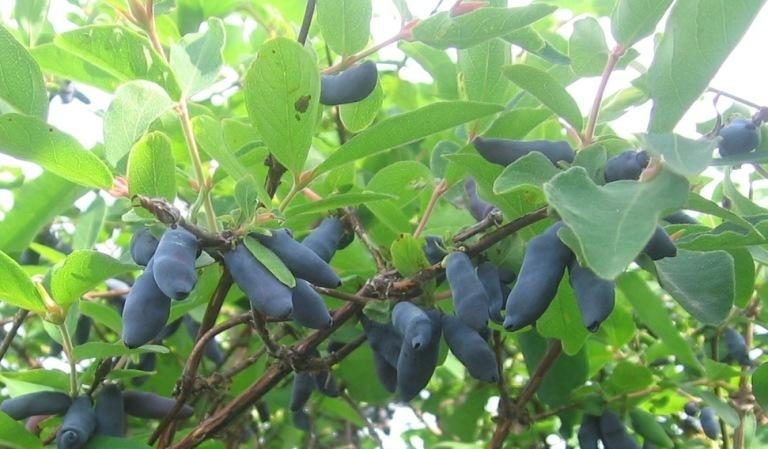
For which regions is it best suited and what are the climate requirements?
Honeysuckle is not the most demanding shrub; it can grow almost anywhere. In the northern regions, it can withstand severe and recurring spring frosts; in the southern regions with a warm climate, some problems are noted. The shrub can bloom again in the fall or during prolonged winter thaws. Then we can no longer wait for summer flowering and fruiting. In warm winters, the buds can swell and be damaged by frost.
The main advantages and disadvantages of the variety
Silginka has few disadvantages and can be easily prevented; the advantages of the berry significantly distinguish this variety.
Advantages: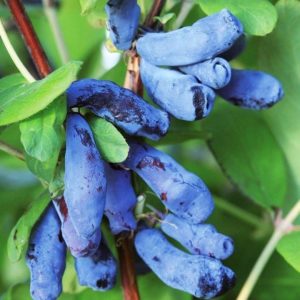
- large fruit;
- early fruiting;
- amicable maturation;
- sweet fruits;
- unpretentiousness;
- drought and disease resistance
- frost resistance;
- crop stability for 30 years;
- good transportability.
The disadvantages include:
- the need for pollination, the deficiency is eliminated by planting a bush of a different variety nearby;
- crumbling - up to 30% of the harvest.
What is the difference from other varieties and hybrids
The main distinguishing feature of the variety is the absence of bitterness in the taste of the berries; they are juicy, sweet and refreshing. Thanks to frost resistance and drought resistance, you don’t have to worry about the plant during cold winters or dry summers.
Agricultural technology
The main requirement for growing shrubs is a free space around it of at least 1.5 m. And for good pollination and harvest, a bush of a different variety is planted nearby.
Honeysuckle prefers light, well-drained areas with plenty of sunlight and no stagnant moisture. Lack of lighting will affect the amount of harvest. Too much clay soil can cause disease.
It is important to prepare a support for the bush; it can be a trellis or trellis. The distance between the support and the bush should be at least 10 cm, for good air circulation and the possibility of pruning the bush.
In the selected area, dig a hole with a depth and width of about 50 cm, approximately oriented on the size of the root system of the bush, it should exceed the size of the root by 10-15 cm.
Soil requirements
Honeysuckle prefers light, well-drained soils. If the soil is too clayey, it is diluted with humus or compost and wood ash is added.
Dates, scheme and rules of planting
The best time to board – end of summer or beginning of autumn. Before the onset of cold weather, the shrub will have time to take root, grow its root system, and in the spring it will begin to actively grow. Autumn planting will allow you to get a harvest in the second year after planting.
Features of cultivation
Honeysuckle is a moisture-loving plant; it will gratefully respond to regular watering, which is carried out in the evening. The main thing is not to allow moisture to stagnate so that the roots do not rot.
Weeding and loosening are also important to enrich the roots with oxygen. They loosen the ground around the bush without burying the tool, since the root system is located close to the surface.
Advice! It is advisable to mulch the soil around the bush; this will help retain moisture and prevent the growth of weeds.Wood chips, straw, sawdust or pine needles work well as mulch - as they decompose, they will provide the shrub with additional nutrition.
Honeysuckle forms a regular crown as it grows and does not need pruning; only dried branches should be trimmed.
It is recommended to feed the bush once, in spring and summer. To do this, take two buckets of compost, 50 g of superphosphate and 50 g of potassium salt. A small furrow is made along the perimeter of the bush, into which fertilizers are poured, filled with water and sprinkled with earth. After flowering, it is important to feed the plant with organic fertilizers containing phosphorus and potassium. This will help the plant gain strength before the long winter.
Pollinators
Even with proper care, it is not always possible to harvest a good harvest of honeysuckle. Although bisexual flowers can pollinate on their own, this does not always happen. Therefore, experienced gardeners advise planting shrubs of a different variety nearby, or, as they are called, pollinator agronomists.
Silginka varieties are well suited for cross-pollination Tomsk, Siberian, Bakcharsky giant, Yugana, Delight, Daughter of a giant. The more species that grow in close proximity, the better the pollination and the greater the berry yield.
Reference! If insects pollinate only one of the flowers, ovaries will form on the entire inflorescence. This will ensure high yields under unfavorable conditions.
Disease and pest control
Silginka is resistant to various diseases, but can sometimes be affected by powdery mildew. This occurs during cold, rainy summers. The leaves are covered with a white coating. For prevention, it is important to remove all foliage under the bush in the fall, as fungal spores can overwinter in it. The biological product “Fitosporin” helps in the fight against powdery mildew.
Pollen flies, aphids, scale insects, and leaf rollers are the most dangerous enemies for honeysuckle. These insects capture the leaves and young shoots of the plant and draw out all the juice from them. “Agrovertin”, “Fitoverm” will be excellent helpers for fighting insects.
Harvest and storage
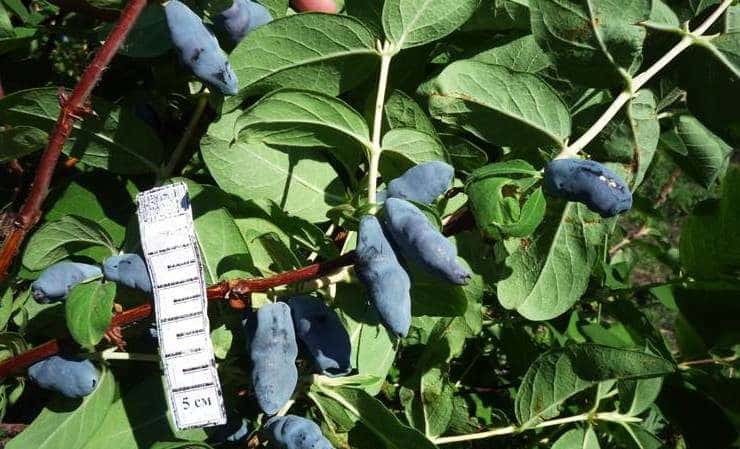
Honeysuckle berries ripen gradually, starting from the top of the bush; on the lower branches, ripening will take place last.
The first harvest of Salminka can be harvested in early June.
The ripening of the berries occurs gradually - from the top of the bush, so the harvest is harvested in several stages. It’s very convenient to spread a film under the bush and shake the branches; the ripe berries will sprinkle and can be easily collected. The collected berries are cleaned of debris, leaves and twigs, and then stored. Store berries in the refrigerator for no longer than a week.
Storage Features
Transport must be carried out with care and only over short distances. Tender berries are easily damaged.
Preparing for winter
Honeysuckle is frost-resistant and does not require special preparation for winter. You can carry out small pruning of dried or creeping branches on the ground.
Reproduction
Reproduction is carried out in several ways:
- By layering. To do this in the spring, it is enough to bury a side branch, without separating it from the mother plant, and water it.
- Dividing the bush. An overgrown bush is simply dug up and replanted.
- Seeds. This is a very complex and troublesome method and is used mainly by breeders. After separation, the seeds are put in the refrigerator for a month, then sown in containers and buried under the snow. In spring, they are planted in the ground. The harvest with this planting method will have to wait several years.
- Cuttings. To do this, the branch is broken off and placed in a greenhouse; after the roots appear, it is planted in the ground. Only annual green twigs are suitable.
Difficulties in growing
With proper planting in a bright area protected from the wind, and the presence of pollinating shrubs nearby, Silginka honeysuckle will not cause any trouble and will delight you with a rich harvest.
Reviews from experienced gardeners about the variety
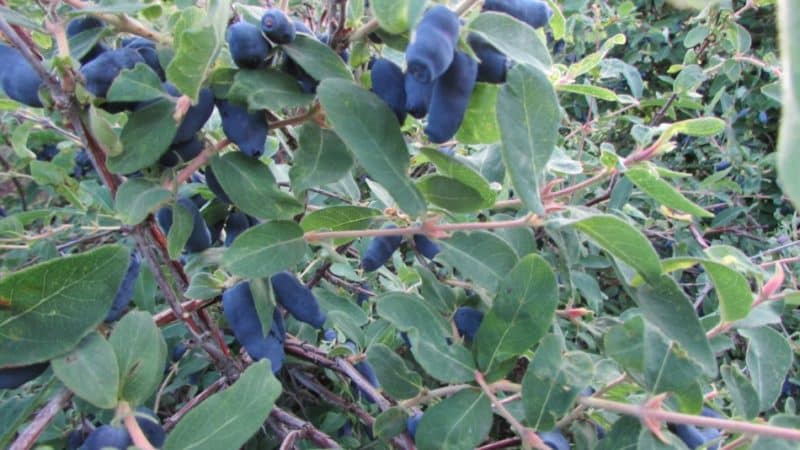
Summer residents from different regions of the country speak only positively about the old variety.
Peter, Naro-Fominsk: “Silginka showed itself worthy on my site. It produces a good harvest every year, the berries are very sweet, without bitterness. The grandchildren eat with pleasure.”
Anna, Volzhsky: “We planted Silginka for our son, the berry is early and rich in vitamins. Even without fertilizers, if the weather is favorable, we harvest the first harvest in May. The berries are tasty, sweet and without sourness. I make preserves, jams, and compotes.”
Conclusion
Honeysuckle will delight gardeners with delicious berries and help cope with spring vitamin deficiency. You just have to plant several varieties of this delicious berry on your plot and you will be guaranteed a harvest of juicy and tasty fruits.